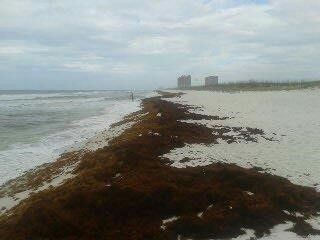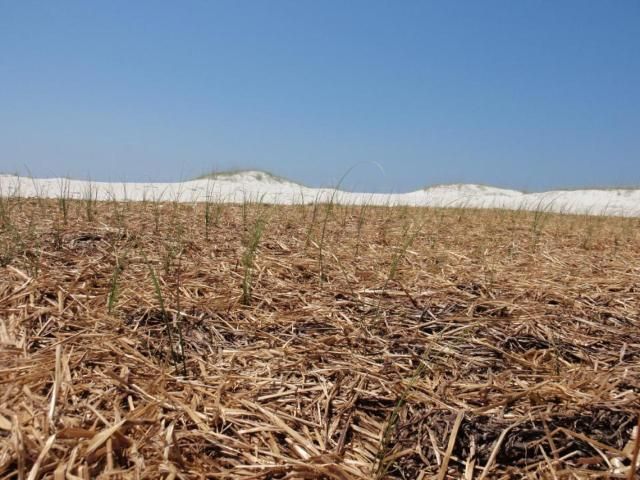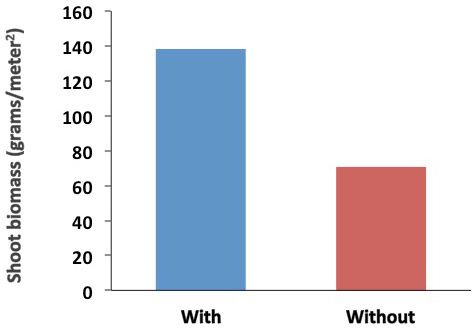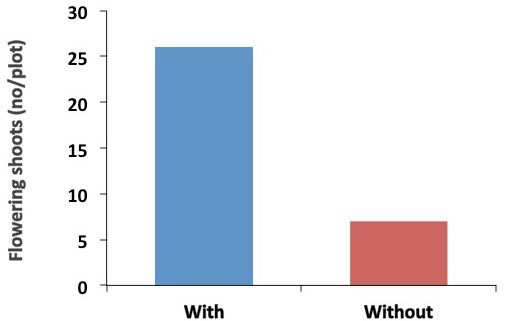Increasing stresses on our beaches and coastal dunes cause changes to occur too quickly or too frequently for natural processes to repair. Recovery of these damaged areas requires the development and use of more effective restoration strategies. Coastal grasses have long been recognized as the biological engineers of our dunes. These plants build dunes by capturing and stabilizing moving sand. To promote growth of new dunes or to repair damaged dunes, perennial grasses, such as sea oats (Uniola paniculata) are often planted after dunes have been eroded, fragmented, or destroyed. Survival of transplanted, nursery grown sea oats is variable, and growth can be slow. Additions of commercial fertilizers and the addition of water-absorbing gels are often recommended to increase survival and speed growth of transplants, but these products are not always effective and can be expensive. More effective, cheaper restoration alternatives are needed (Hooton 2014).
Wrack, defined as beach litter consisting of "algae, grasses, driftwood, fruits, seeds, and carrion, along with cultural litter" that accumulates at the high tide line (wrack line) or after storms is an important resource to wildlife and provides many benefits to the development of beach dunes (Behbehani and Croker 1982; Orr et al. 2005; Dugan et al. 2003; Nordstrom et al. 2011) (Figure 1). Wrack has a rough surface that allows it to catch seeds of dune plants and sand as they blow in the wind, promoting sand accumulation. Trapped seeds commonly germinate and grow with the help of wrack (Figure 2). As wrack ages, it supplies nutrients, protection, and moisture that assist plant survival and growth. Seagrasses in wrack act as a nitrogen source for coastal dune plants, while brown algae, also found in wrack, can be an important supplier of nitrogen and phosphorus to plants (Williams and Feagin 2010). For these reasons, wrack serves an important role in shoreline ecology and should be left in place. However, the Florida Fish and Wildlife Conservation Commission (https://myfwc.com/wildlifehabitats/wildlife/sea-turtle/beach-activities/beach-cleaning-guidelines/) allows mechanical cleaning of beaches during certain times of the year. Discarding wrack collected during mechanical beach cleanings wastes a valuable resource. Instead of disposing of wrack collected during beach cleaning, it may be feasible to place wrack near native dune plants to enhance growth of dune vegetation. Alternatively, an organic substance like wheat straw may provide similar benefits. The potential of using organic substances similar to wrack to enhance growth of dune vegetation was recently tested on Florida beaches with the use of wheat straw as a surrogate wrack. We applied a layer of wheat straw to restoration planting sites to determine the feasibility of using wrack and or similar cost-effective organic substances in coastal dune revegetation/restoration projects to (1) increase transplant survival, (2) accelerate the growth of coastal dune plants, and (3) enhance dune building through sand accumulation. We expected increases in survival and growth of planted sea oats and increases in sand accumulation.

Credit: Mack Thetford, UF/IFAS

Credit: Mack Thetford, UF/IFAS
Sea Oats Planting and Surrogate Wrack (Wheat Straw) Placement
Six planting sites were located on sand flats parallel to the Gulf on Perdido Key, Florida. Plugs of sea oats spaced approximately 1 foot apart were planted in the spring (Figure 3). Sea oats were planted two weeks before surrogate wrack (wheat straw) was applied; however, the delay in applying surrogate wrack was not by design and may not be necessary. At each site, five bales of wheat straw were placed on half of the sea oats planting; the remaining half of the sea oats planting remained bare. The wheat straw (surrogate wrack) layer measured approximately 8 inches in depth (Figure 4).

Credit: Natalie Hooten

Credit: Natalie Hooten
Plant Growth
We found that survival of spring-planted sea oats was greater than 97% and was the same with or without surrogate wrack (wheat straw) (Hooton 2014). However, when planting in the summer or in drier years survival may be greater with surrogate wrack than without because of the water-holding capacity of the wrack. Just six months after planting, all measures of plant growth (shoot height, shoot number, and the weight of aboveground standing plant material) were significantly greater for sea oats planted with surrogate wrack (wheat straw) than without surrogate wrack. Greater lateral spread of underground stems resulted in significantly greater plant width with surrogate wrack than without. Two years after planting, growth of leaves and shoots remained greater with surrogate wrack than without surrogate wrack (Figure 5). Surrogate wrack also resulted in more plants maturing to flowering size in year two. The number of flowering shoots was greater with surrogate wrack than without (Figures 6 and 7) two years after planting.

Credit: Debbie Miller, UF/IFAS

Credit: Debbie Miller, UF/IFAS

Credit: Sean Claypool, UF/IFAS
Sand Accumulation
Both planting of sea oats and the presence of surrogate wrack increased sand accumulation. Sand did not accumulate where plants were not present. The dune built by the planting reached about 1.5 feet above the surrounding sand (no plants) two years after planting (Figures 7 and 8). Sand accumulation (created dune height) was notably greater with surrogate wrack than without wrack, even after eight months. Two years after planting, the section of the created dune with both sea oats and surrogate wrack had accumulated more sand than the section where sea oats were planted without surrogate wrack (Figures 7 and 8).

Credit: Debbie Miller, UF/IFAS
Why do we think surrogate wrack increases plant growth and dune growth?
- Surrogate wrack may capture and hold precipitation near the surface and increase available moisture.
- Increased moisture may contribute to increased growth of sea oats with surrogate wrack.
- Increased nutrients from the surrogate wrack may also contribute to increased growth of sea oats.
Implications for Dune Restoration
- Surrogate wrack such as wheat straw can potentially benefit coastal dune restoration by increasing the rate of growth of dune grasses such as sea oats.
- Surrogate wrack used with sea oats improves sand accumulation in addition to the spread of sea oats by lateral growth of underground stems. This demonstrates that surrogate wrack and potentially natural wrack collected from beach cleaning could be used to assist dune building.
- Surrogate wrack can be used to decrease the time to first flowering for transplanted sea oats. Greater flowering of sea oats would provide a food source for wildlife and improve the spread of sea oats by seed/seedlings.
References
Behbehani, M. I., and R. A. Croker. 1982. "Ecology of beach wrack in northern New England with special reference to Orchestria platensis." Estuarine, Coastal, and Shelf Science 15:611–620.
Hooton N., D. L. Miller, M. Thetford, and B. S. Claypool. 2014. "Survival and growth of planted Uniola paniculata and dune building using surrogate wrack on Perdido Key Florida, U.S.A." Restoration Ecology 22(5) 710–707.
Dugan, J. E., D. M. Hubbard, M. D. McCrary, and M. O. Pierson. 2003. "The response of macrofauna communities and shorebirds to macrophyte wrack subsidies on exposed sandy beaches of southern California." Estuarine, Coastal and Shelf Science 58S:25–40.
Nordstrom, K. F., N. L. Jackson, K. H. Korotky, and J. A. Puleo. 2011. "Aeolian transport rates across raked and unraked beaches on a developed coast." Earth Surface Processes and Landforms DOI: 10.1002/esp.2105
Orr, M., M. Zimmer, D. E. Jelinski, and M. Mews. 2005. "Wrack deposition on different beach types: spatial and temporal variation in the pattern of subsidy." Ecology 86:1496–1507.
Williams, A. M. and Feagin, R. A. 2010. "Sargassum as a natural solution to enhance dune plant growth." Environmental Management 46: 738–747.